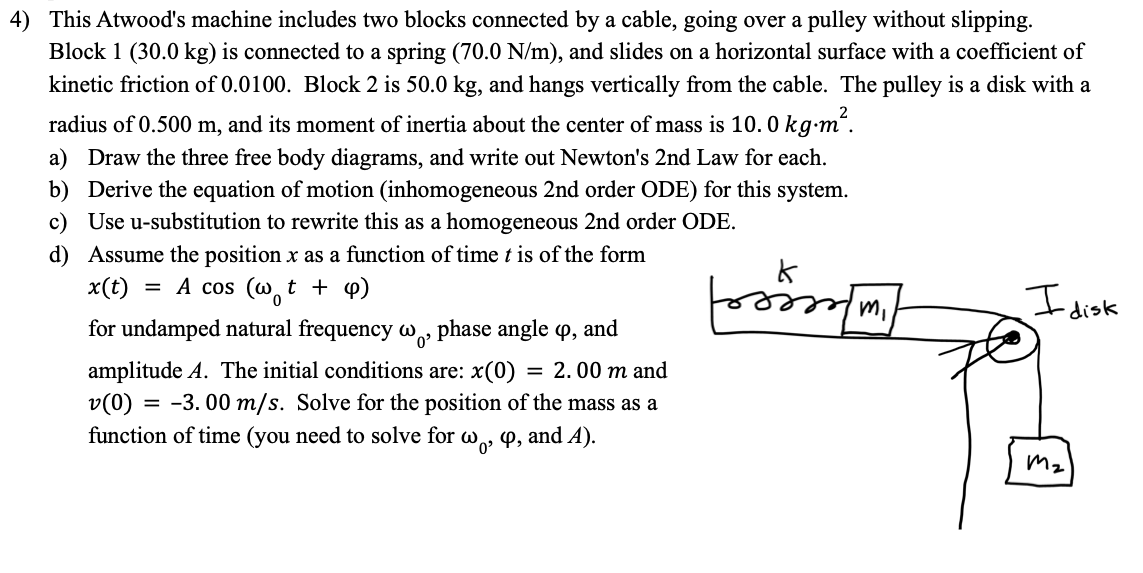4) This Atwood's machine includes two blocks connected by a cable, going over a pulley without slipping. Block 1 (30.0 kg) is connected to a spring (70.0 N/m), and slides on a horizontal surface with a coefficient of kinetic friction of 0.0100. Block 2 is 50.0 kg, and hangs vertically from the cable. The pulley is a disk with a
4) This Atwood's machine includes two blocks connected by a cable, going over a pulley without slipping. Block 1 (30.0 kg) is connected to a spring (70.0 N/m), and slides on a horizontal surface with a coefficient of kinetic friction of 0.0100. Block 2 is 50.0 kg, and hangs vertically from the cable. The pulley is a disk with a
Elements Of Electromagnetics
7th Edition
ISBN:9780190698614
Author:Sadiku, Matthew N. O.
Publisher:Sadiku, Matthew N. O.
ChapterMA: Math Assessment
Section: Chapter Questions
Problem 1.1MA
Related questions
Question

Transcribed Image Text:4) This Atwood's machine includes two blocks connected by a cable, going over a pulley without slipping.
Block 1 (30.0 kg) is connected to a spring (70.0 N/m), and slides on a horizontal surface with a coefficient of
kinetic friction of 0.0100. Block 2 is 50.0 kg, and hangs vertically from the cable. The pulley is a disk with a
radius of 0.500 m, and its moment of inertia about the center of mass is 10. 0 kg-m“.
a) Draw the three free body diagrams, and write out Newton's 2nd Law for each.
b) Derive the equation of motion (inhomogeneous 2nd order ODE) for this system.
c) Use u-substitution to rewrite this as a homogeneous 2nd order ODE.
d) Assume the position x as a function of time t is of the form
x(t) = A cos (wt + p)
I disk
for undamped natural frequency w, phase angle P, and
amplitude A. The initial conditions are: x(0)
v(0) = -3. 00 m/s. Solve for the position of the mass as a
function of time (you need to solve for w, 4, and A).
= 2. 00 m and
Mz
Expert Solution
This question has been solved!
Explore an expertly crafted, step-by-step solution for a thorough understanding of key concepts.
This is a popular solution!
Trending now
This is a popular solution!
Step by step
Solved in 2 steps with 1 images

Knowledge Booster
Learn more about
Need a deep-dive on the concept behind this application? Look no further. Learn more about this topic, mechanical-engineering and related others by exploring similar questions and additional content below.Recommended textbooks for you

Elements Of Electromagnetics
Mechanical Engineering
ISBN:
9780190698614
Author:
Sadiku, Matthew N. O.
Publisher:
Oxford University Press

Mechanics of Materials (10th Edition)
Mechanical Engineering
ISBN:
9780134319650
Author:
Russell C. Hibbeler
Publisher:
PEARSON

Thermodynamics: An Engineering Approach
Mechanical Engineering
ISBN:
9781259822674
Author:
Yunus A. Cengel Dr., Michael A. Boles
Publisher:
McGraw-Hill Education

Elements Of Electromagnetics
Mechanical Engineering
ISBN:
9780190698614
Author:
Sadiku, Matthew N. O.
Publisher:
Oxford University Press

Mechanics of Materials (10th Edition)
Mechanical Engineering
ISBN:
9780134319650
Author:
Russell C. Hibbeler
Publisher:
PEARSON

Thermodynamics: An Engineering Approach
Mechanical Engineering
ISBN:
9781259822674
Author:
Yunus A. Cengel Dr., Michael A. Boles
Publisher:
McGraw-Hill Education

Control Systems Engineering
Mechanical Engineering
ISBN:
9781118170519
Author:
Norman S. Nise
Publisher:
WILEY

Mechanics of Materials (MindTap Course List)
Mechanical Engineering
ISBN:
9781337093347
Author:
Barry J. Goodno, James M. Gere
Publisher:
Cengage Learning

Engineering Mechanics: Statics
Mechanical Engineering
ISBN:
9781118807330
Author:
James L. Meriam, L. G. Kraige, J. N. Bolton
Publisher:
WILEY